The Glaciers of Glacier
The glaciers of Glacier National Park are melting. This is no secret. In fact, the glaciers have been melting for about 150 years. In the past few decades, though, the melting rate has increased remarkably.
In Glacier National Park, there are three criteria for calling a mass of snow and ice a glacier:
• It must be moving downhill.
• It must be at least 100 feet thick.
• It must be at least 25 acres in area.
Some additional facts about the glaciers of Glacier:
• Today's glaciers formed a few thousand years ago during a colder period in our planet's history.
• The glaciers were at their apex in number and size at the end of the Little Ice Age, which scientists generally agree ended about 1850.
• At the end of the Little Ice Age, what is now Glacier National Park had about 150 glaciers. Today, there are about 25 left.
• The glaciers have been in a melting trend ever since 1850, though there have been periods up until 1980 during which they did expand. Since 1980, they have been receding more rapidly than they had in the past.
• For several years now, scientists have predicted that the park will cease to have glaciers by 2030, but trends in recent years have some revising that estimate to 2015-2020.
• Even if the 2030 guess turns out to be the best one, it is unlikely that every single glacier in Glacier will be gone by then; some of the largest ones are not melting as rapidly as many of the others are (Blackfoot Glacier, for example). However, there can be little doubt that if not all of the glaciers are gone by then, the remaining ones will be substantially smaller than they are today.
Siyeh Glacier
Nestled beneath some of Glacier's most imposing walls-- those of and adjacent to the north face of
Mount Siyeh-- in a cirque housing Cracker Lake, one of Glacier's most spectacular, Siyeh Glacier is one of the park's "former" glaciers.
From the
Wikipedia page for Siyeh Glacier:
"Siyeh Glacier is located in the U.S. state of Montana in Glacier National Park. The glacier lies in a deep cirque to the north of Mount Siyeh at an elevation between 7,200 feet (2,200 m) and 6,800 feet (2,100 m) above sea level. The glacier covers an area of less than 10 acres (0.040 km2) and does not meet the threshold of 25 acres (0.10 km2) often cited as being the minimum size to qualify as an active glacier. Siyeh Glacier has experienced massive retreat and lost over 73 percent of its surface area between 1966 and 2005."
So in 1966, Siyeh Glacier was around 37 acres, almost four times its current size.
But I am happy to report that the glacier, despite its diminished stature and getting a bit of the "Pluto Treatment" when it comes to the glacier lists, is still alive and kicking...or cracking.
For now.
Cracker Lake
To get to Siyeh Glacier, one must first get to Cracker Lake, which is probably the most stunningly colored lake in Glacier that is accessible by a day hike (others might argue for Grinnell Lake or Upper Grinnell Lake). Fed by the melting Siyeh Glacier, mile-long Cracker Lake, due to all the glacial flour (silt) deposited in it from the glacier's runoff, is an opaque turquoise in hue. Many people whose first view of the lake is by looking at someone else's picture of it find it hard to believe that the picture has not been photoshopped, but it probably hasn't been.
And the north face of Mount Siyeh, which represents probably the hardest established climbing route in the park (25+ pitches of Class 5, 5.9, A2 and Grade V or VI), rises more than 4000' above the 5910' lake. It's quite a setting.
Cracker Lake also was the site of mining activity in the past, and some of the ruins are still there today. A little information about the mining:
By 1910, when Glacier National Park was finally formed, only a small number of these consolidated claims remained. Specifically, the major claims included the Bulls Head group operated by the Josephine Copper Mining and Smelting Company in the Swiftcurrent Valley; the Reid Mining, Milling and Smelting Co. (known as the Van Pelt claims) on the North Fork of Kennedy Creek (today's Slide Lake area); and the Michigan and Montana Copper Mining and Smelting Company at Cracker Lake. At the Cracker Lake mine, a tunnel had been driven some thirteen hundred feet into the mountain, including some four hundred feet along the vein. But even though a sawmill was built, a concentrator erected, and assays looked promising, a "well known mining expert of Helena, representing a mining syndicate" examined the various locations and apparently discouraged further development. The Cracker Lake concentrator never operated, but individuals like Frank Stevenson, Mike Cassidy, and a few others remained in the area, hoping eventually to prosper. Some of these mining claims still remain in private ownership within Glacier today.
NPS Source
The hike in is a bit over 6 miles and only gains 1400'. Although the first couple of miles are pretty dull, the scenery starts picking up as the trail bends south past Cracker Flats and begins climbing up the drainage of Canyon Creek, colored beautifully most of its course by outflow from Cracker Lake.
Unfortunately, the trail is popular with horseback riders, and every other day in summer, guided groups go to Cracker Lake and back. This means that the trail can be disgusting in places, especially after a rain. If you really can't stand sharing the trail with horses, get an early start so at least the hike in is horse-free or check the schedule so you can plan your hike around the tours.
Even though a trip to Cracker Lake plus a visit to Siyeh Glacier is doable in a long day, it's more enjoyable to spend the night there, and that's just what my wife and I did, obtaining a spot at one of the three sites available at the backcountry campground on a ledge above the lake (note-- to camp here, you must reserve a permit in advance or obtain one the day before or the morning of your hike in).
My only previous visit to Cracker Lake had been way back in August 2000, and that visit, too, had been with my wife. Impressed by the scenery on that nice afternoon and turned off by the horse traffic and trail conditions, I really had no desire to see the lake ever again except from mountaintops. However, we weren't happy with the first backpacking itinerary we received through the park's lottery system and couldn't get something preferred when we arrived at the park, so we had to settle for the permit-issuing ranger taking some pity on us and bending the rules a bit so that we could get
something decent.
In Glacier, a backpacking itinerary begins and ends at a trailhead. Or, to be clearer, you cannot get, for example, a two-nighter that involves hiking in for the night to one location, hiking out the next day, driving to another trailhead, and hiking in. You need two separate one-night itineraries for something like that.
Regardless, the ranger was merciful after I had showed up at opening time on consecutive mornings and failed to get first or second choices both times. What we wound up with was a single permit allowing us to hike into Atlantic Creek in the Cut Bank area, leave the next day, drive to Many Glacier, and then hike up to Cracker Lake.
Excited about packing in on a horse-infested trail just to spend the night in a cirque that featured no reasonable scrambling routes to the closest summits I was not, but we had planned much of the summer trip around backpacking, which we hadn't done together in over 10 years, so I put on a cheerful face and we set off.
As soon as we got there, I did what I always do first upon arriving at a backcountry campsite-- I take out the beers stashed in my backpack and find the coldest place to sink them, which in this case was the lake itself. Then I am able to look forward to a feast of Ramen noodles, beef jerky, chocolate chip cookies, and cold beer for dinner. It doesn't get much better than that when a mountain wilderness sunset is the backdrop.
The other two sites were occupied, but it was a peaceful place nonetheless, enhanced by the presence of diving and calling ospreys, mountain goats ranging from semi-tame to semi-wild, and, in the morning, two bull moose wading on the far side of the lake.
It was a beautiful night with amazing stars, and I spent much of it lying awake and thinking about my spontaneously planned trip out to Siyeh Glacier in the morning.
"Spontaneous" in the sense that the idea came to me when we got to camp and the glacier started capturing my attention, that is. The visible crevasses interested me, and I thought I saw a way to get to them.
Visiting the Glacier
Dawn. A red dawn. Red on the mountains, that is. As if the incredible forms on display in Glacier are not already enough, the mountains glow an intense read at the break of day. Mountains the world over are beautiful, but some have to be seen to be believed. Glacier's are among those.
Glacier's east side is also known for its wind. But this morning, it was not only clear but still as well, and the milky waters of Cracker Lake afforded lovely reflections.
Instead of Siyeh Glacier, though, my first goal was actually to locate what I suspected might be another glacier. Two principal streams feed Cracker Lake. One is from Siyeh Glacier, but the other is from the other side of a ridge separating Siyeh Glacier's basin from another one. Trudging up a slope so steep that sometimes I had to use my hands even though it was only Class 2, I finally reached the top of the ridge and was rewarded for my efforts by discovering that indeed there is another glacier (technically, not a glacier due to size, but for all other intents and purposes a glacier). The sun was not yet on the ice, so I hung around waiting for it in order to have some pre- and post-sun pictures of the glacier.
While up there, I met one of the local denizens, a mountain goat significantly less used to people than the ones frequenting the campground were. The goat was on the ridge as well, between me and a sheer mountain wall.
Curious to see how close I could get, I approached slowly, but the goat kept retreating to keep the same distance between us. Never did I expect that to get away from me, it would get onto the cliffs I thought it would descend one side of the ridge if necessary), but that's exactly what it did. With amazement and concern, I watched it do what would be impossible for a human, delicately but surely stepping along the mountainside, just inches from oblivion. Finally, getting worried that my presence was going to panic the goat into a mistake or make it go where even
it couldn't, I backed off, not wanting my curiosity to be the cause of its death.
Can you see the goat below?
Then I descended back to the snowfields that mark the lower ends of Siyeh Glacier. Ascending the steepening snow was easy at first, but when things got icy, I had to work along the edges since I had no axe or crampons. Some tricky scrambling got me up to the glacier, where my jaw just dropped and I went crazy with the camera, amazed at the beautiful forms and colors among the ice at Siyeh Glacier. I was able to enter the shallow crevasses at the leading edge of the glacier and safely observed what it is like inside a glacier. But when the sun hit the ice, I was amazed at how much dripping there was and how fast it was, and the sounds of ice cracking told me to get the hell out as soon as possible!
Mark Twain famously wrote, "The reports of my death have been greatly exaggerated."
So is the idea that Siyeh Glacier is dead.
For now.
Oh, one last thing...
I almost forgot to include one for the people who hate pictures of flowers and bugs. Here's a two-for-one special!




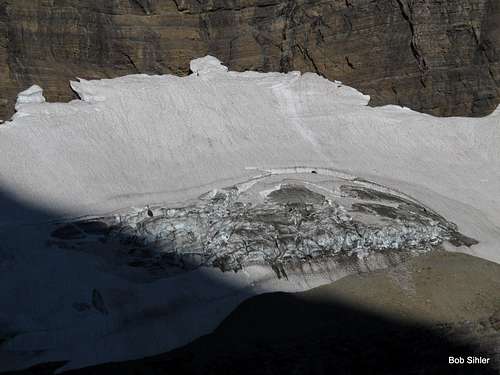
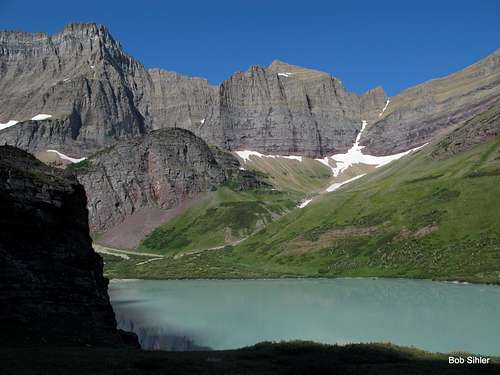
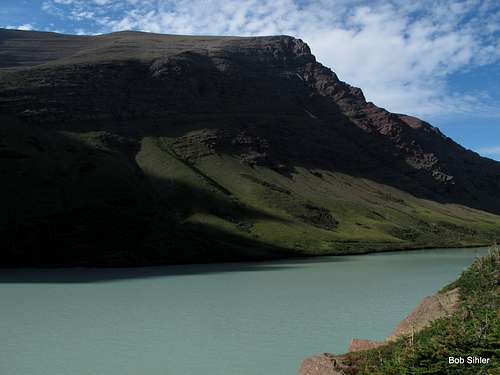
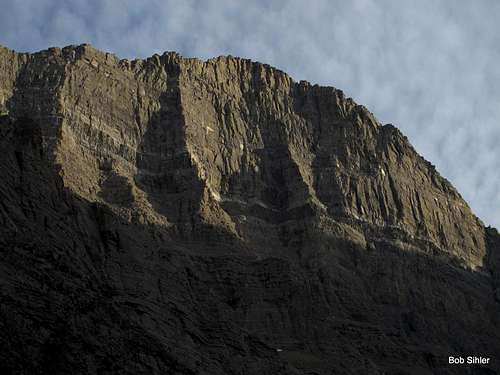
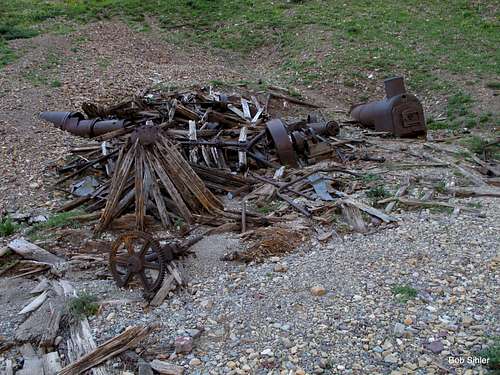
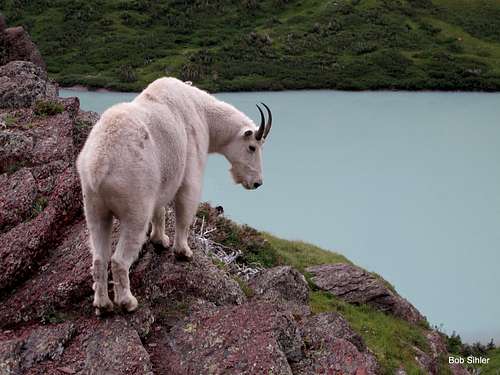
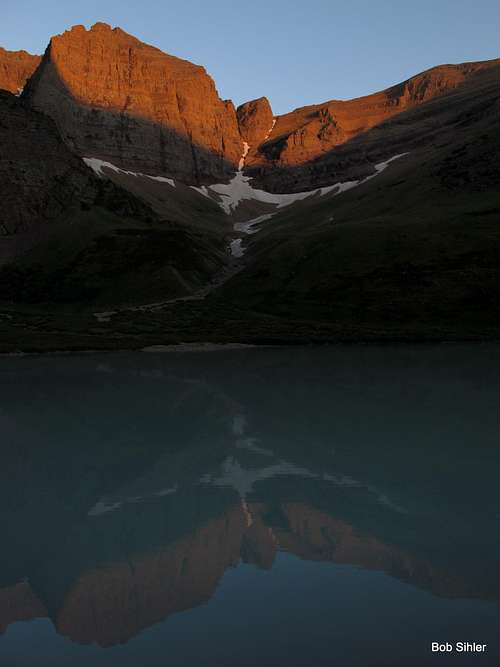









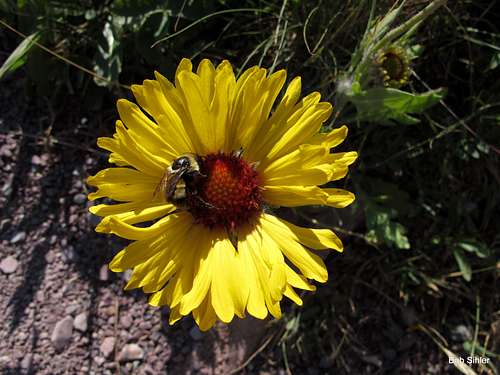




Comments
Post a Comment